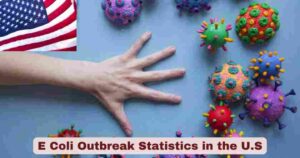Infant Botulism Cases in America 2025
Infant botulism remains one of the most concerning neurological emergencies affecting babies under 12 months of age across the United States in 2025. This rare but potentially life-threatening condition occurs when infants ingest spores of the bacterium Clostridium botulinum, which then colonize their immature intestinal tract and produce a powerful neurotoxin. Unlike foodborne botulism seen in older children and adults where preformed toxin is consumed, infant botulism develops when these spores germinate inside the baby’s gut, multiply, and release toxin that gets absorbed into the bloodstream. The toxin blocks nerve signals to muscles, causing progressive weakness that typically starts with constipation and difficulty feeding, then advances to more severe symptoms including loss of head control, weak crying, and in serious cases, respiratory failure requiring mechanical ventilation.
The year 2025 has marked a significant moment in infant botulism surveillance with an unprecedented multistate outbreak linked to contaminated infant formula, bringing renewed attention to this disease that typically affects approximately 100 to 181 infants annually in the United States. This outbreak has affected multiple states and resulted in 31 confirmed or suspected cases as of November 19, 2025, all requiring hospitalization and treatment with the specialized antitoxin BabyBIG. While infant botulism accounts for roughly 70% of all botulism cases nationally, making it the most common form of the disease, each case represents a medical emergency requiring immediate intervention. Understanding the current statistics, risk factors, geographic distribution, and clinical presentation of infant botulism in the US in 2025 is essential for parents, caregivers, and healthcare providers to recognize symptoms early and ensure prompt treatment that can prevent severe complications and save lives.
Interesting Stats & Facts About Infant Botulism in the US 2025
| Fact Category | Key Information |
|---|---|
| Most Common Botulism Type | Infant botulism represents approximately 70% of all new botulism cases annually in the United States |
| National Incidence Rate | 1.9 cases per 100,000 live births resulting in around 77 to 100 new cases each year under normal circumstances |
| Historic High Year | 2021 recorded the highest annual case count with 181 laboratory-confirmed cases since infant botulism was first characterized in 1976 |
| 2025 Outbreak Impact | As of November 19, 2025, 31 infants with suspected or confirmed infant botulism from 15 states in current formula-linked outbreak |
| Treatment Recipients 2025 | Between August 1 and November 10, 2025, 84 infants nationwide received BabyBIG treatment |
| Hospitalization Rate | More than 99% of infant botulism cases require hospitalization |
| Survival Rate | With modern treatment including BabyBIG, mortality has decreased from nearly 90% a century ago to less than 15% today |
| Peak Season | Case occurrence typically peaks during summer and fall months |
| Age Most Affected | Median age at onset is 3 to 4 months, with more than 90% of cases occurring in infants younger than 6 months |
| Gender Distribution | Boys and girls are affected equally, with 50% male and 50% female distribution |
| Honey Connection | Approximately 20% of infant botulism cases are linked to raw honey consumption |
| Toxin Potency | Botulinum toxin is one of the most powerful known toxins with a lethal dose as low as 1 microgram per kilogram of body weight |
| Treatment Cost | BabyBIG treatment costs approximately $50,000 per dose |
| Intubation Rate | Approximately 50% of infant botulism cases require intubation and mechanical ventilation |
| California Leadership | California consistently reports the most cases, accounting for 25-28% of all infant botulism cases nationally |
Data sources: CDC National Botulism Surveillance Summary 2021, CDC Infant Botulism Outbreak Investigation November 2025, FDA Outbreak Investigation November 2025, NCBI StatPearls Infantile Botulism 2025
The fascinating aspect of infant botulism lies in its unique pathophysiology compared to other forms of botulism. While adults and older children typically develop botulism from consuming preformed toxin in contaminated food, infants are vulnerable due to their immature gut microbiota, reduced gastric acidity, and limited protective bacterial flora. These factors create a window of opportunity for Clostridium botulinum spores to germinate and colonize the large intestine. The spores themselves are ubiquitous in the environment, found in soil, dust, and aquatic sediments worldwide, yet infant botulism remains relatively rare, affecting fewer than 2 in every 100,000 live births annually.
What makes 2025 particularly significant is the unprecedented outbreak linked to ByHeart Whole Nutrition Infant Formula, which represented only 1% of all infant formula sales in the United States yet accounted for more than 40% of formula-exposed infant botulism cases during the outbreak period. This disproportionate representation led to the recall of all ByHeart formula products nationwide on November 11, 2025. The California Department of Public Health’s Infant Botulism Treatment and Prevention Program detected preliminary laboratory evidence of Clostridium botulinum bacteria in an opened formula can fed to an affected infant, marking a rare instance where infant formula was definitively linked to botulism cases.
Latest Statistics on Infant Botulism Cases in the US 2025
| Statistical Measure | 2025 Data | Comparison/Context |
|---|---|---|
| Total Outbreak Cases (as of Nov 19, 2025) | 31 infants | Multistate outbreak linked to infant formula |
| States Affected in Outbreak | 15 states | Arizona, California, Idaho, Illinois, Kentucky, Maine, Michigan, Minnesota, New Jersey, North Carolina, Oregon, Pennsylvania, Rhode Island, Texas, Washington |
| Hospitalizations | 31 (100%) | All outbreak cases required hospitalization |
| Deaths Reported | 0 | No deaths in 2025 outbreak |
| BabyBIG Treatments (Aug-Nov 2025) | 84 infants | Total recipients nationwide during outbreak period |
| Formula-Exposed Cases | 36 infants (43%) | Among 84 treated, had any powdered formula exposure |
| ByHeart Formula Cases | 15+ infants | More than 40% of formula-exposed cases consumed ByHeart |
| Illness Onset Range | August 9 – November 13, 2025 | Period when outbreak cases became ill |
| Age Range Outbreak | 16 to 200 days | Youngest approximately 2 weeks, oldest nearly 7 months |
| Female Cases | 11 out of 24 (46%) | Gender distribution among cases with available data |
| Historical Annual Average | 100-181 cases | Normal year sees 77-181 infant botulism cases nationwide |
Data sources: CDC Investigation Update Infant Botulism Outbreak November 19, 2025; FDA Outbreak Investigation November 14, 2025
The 2025 statistics reveal a concerning spike in infant botulism cases during the latter half of the year, primarily concentrated in a three-month window from August through November. This represents a significant deviation from typical patterns, where cases are more evenly distributed throughout the year with a peak during summer and fall months. The fact that 84 infants received BabyBIG treatment during just a three-month period (August 1 to November 10, 2025) suggests that 2025 may approach or potentially exceed the historic high of 181 cases set in 2021.
The geographic distribution of the 2025 outbreak is notable for spanning 15 states across multiple regions of the country, from the West Coast (California, Oregon, Washington, Idaho) to the East Coast (Maine, Rhode Island, New Jersey, Pennsylvania, North Carolina), and throughout the Midwest (Illinois, Michigan, Minnesota) and Southwest (Arizona, Texas). This wide distribution reflects the nationwide availability of the implicated ByHeart formula, which was sold online and at major retailers across the United States. The outbreak investigation identified that illness onset dates ranged over a four-month period, with the earliest cases becoming symptomatic on August 9, 2025, and the most recent on November 13, 2025.
The age distribution of affected infants in the 2025 outbreak aligns with historical patterns, with cases ranging from 16 to 200 days of age. This corresponds to approximately 2 weeks to nearly 7 months, falling well within the typical vulnerable period where infants are most susceptible to botulism toxin. The median age of 3 to 4 months observed in broader surveillance data reflects the fact that infants in this age range have not yet developed the protective intestinal flora and gastric acidity that help prevent Clostridium botulinum spore germination in older children and adults.
Historical Infant Botulism Case Counts in the US 2017-2021
| Year | Total Infant Botulism Cases | Toxin Type A | Toxin Type B | States Reporting | California Cases | Pennsylvania Cases |
|---|---|---|---|---|---|---|
| 2017 | 141 | Data available | Data available | 31 states | Highest reporter | Second highest |
| 2018 | 162 | 69 (43%) | 87 (54%) | 31 states | 38 (23%) | 27 (17%) |
| 2019 | 152 | 50 (33%) | 97 (64%) | 32 states | 43 (28%) | 17 (11%) |
| 2020 | 159 | 64 (40%) | 93 (58%) | 32 states | 42 (26%) | 23 (14%) |
| 2021 | 181 | 72 (40%) | 107 (59%) | 31 states | 45 (25%) | 21 (12%) |
Data source: CDC National Botulism Surveillance Summaries 2017-2021
The five-year historical data from 2017 to 2021 demonstrates important trends in infant botulism epidemiology across the United States. Most notably, 2021 recorded the highest annual case count of 181 laboratory-confirmed cases since infant botulism was first characterized in 1976, representing a 28% increase from 2017. The years 2018 and 2020 also showed elevated case counts with 162 and 159 cases respectively, indicating a general upward trend in diagnosed cases over this period.
The toxin type distribution reveals consistent patterns, with Type B predominating in most years, accounting for 54% to 64% of cases, while Type A comprises 33% to 43%. This distribution reflects the geographic prevalence of different Clostridium botulinum toxin types in soil across the United States. Type A is most prevalent west of the Mississippi River, while Type B is more common in the eastern United States. Rare toxin types including Ba (bivalent strains producing both A and B toxins), Bf (bivalent B and F), and Type F alone account for less than 2% of cases combined.
California and Pennsylvania consistently emerge as the states reporting the highest number of infant botulism cases throughout the five-year period. California alone accounted for 23% to 28% of all national cases annually, with case counts ranging from 38 to 45 per year. Pennsylvania ranked second, reporting 11% to 17% of cases with annual counts between 17 and 27 cases. These two states combined represent approximately 35% to 40% of all infant botulism cases in the United States, despite housing only a fraction of the national population. This geographic concentration is attributed to environmental factors, particularly soil composition and the presence of Clostridium botulinum spores in certain regions.
The number of states reporting cases remained relatively stable at 31 to 32 states per year, indicating that infant botulism occurs nationwide but with significant geographic variation in incidence rates. The consistent reporting from approximately two-thirds of U.S. states suggests widespread environmental exposure to botulinum spores, but varying rates of actual disease development based on local spore concentrations, soil types, and other environmental factors.
Symptoms and Clinical Presentation of Infant Botulism in the US 2025
| Symptom Category | Clinical Manifestations | Timeline/Characteristics |
|---|---|---|
| Initial Symptom | Constipation | Often the first sign, may precede other symptoms by days |
| Feeding Difficulties | Poor sucking and swallowing, difficulty breastfeeding or taking bottle | Usually first noticed symptom that prompts medical attention |
| Cry Changes | Weak, altered, or feeble cry | Distinctly different from infant’s normal cry |
| Head Control Loss | Inability to lift or support head, lack of head control | Progressive weakness of neck muscles |
| Facial Weakness | Fewer facial expressions, drooping eyelids (ptosis), diminished smile | Loss of normal animated expressions |
| Eye Symptoms | Pupils slow to react to light, drooping eyelids, difficulty tracking objects | Ocular muscle involvement |
| Generalized Weakness | “Floppy baby” appearance, hypotonia, reduced muscle tone throughout body | Descending bilateral paralysis pattern |
| Respiratory Compromise | Difficulty breathing, shallow respirations, respiratory failure | Life-threatening complication requiring ventilation |
| Autonomic Symptoms | Reduced tear production, excessive drooling, decreased saliva | Autonomic nervous system dysfunction |
| Symptom Onset Period | 3 days to several weeks after exposure | Incubation highly variable, can take up to 30 days |
Data sources: CDC Clinical Overview Infant Botulism 2024, CDC Infant Botulism Outbreak 2025, NCBI StatPearls 2025
The clinical presentation of infant botulism in 2025 follows a characteristic pattern that healthcare providers and parents must recognize for early intervention. Unlike adult botulism which can present acutely, infant botulism typically develops gradually over several days, making early recognition challenging. The disease manifests as a descending, bilateral flaccid paralysis, meaning weakness starts in the head and neck region and progressively moves downward through the body if untreated.
Constipation is frequently the initial symptom, occurring days before parents notice other signs. However, the constellation of symptoms that typically brings infants to medical attention includes difficulty feeding coupled with weak crying and loss of head control. Parents often describe their previously healthy baby suddenly struggling to nurse or take a bottle, with weak sucking and swallowing motions. The altered cry is particularly distinctive—parents report it sounds different, weaker, or more feeble than the infant’s normal cry. This change in vocalization occurs because the toxin affects the muscles controlling the vocal cords and respiratory system.
The “floppy baby” appearance is a hallmark of infant botulism, with affected infants displaying marked hypotonia or decreased muscle tone throughout their body. When picked up, these babies feel limp and lack the normal muscle tension seen in healthy infants. The facial expression changes are equally striking, with affected babies showing fewer smiles, limited ability to animate their faces, and drooping eyelids that give a sleepy or sedated appearance even when the infant is alert. Pupils may be sluggish to react when exposed to light, another sign of neurological impairment.
The most concerning progression of infant botulism involves respiratory muscles. As weakness descends through the body, it eventually affects the diaphragm and intercostal muscles responsible for breathing. Approximately 50% of infant botulism cases require intubation and mechanical ventilation, representing a life-threatening emergency. Early recognition and treatment with BabyBIG can potentially prevent progression to respiratory failure, though even treated infants may require ventilatory support.
The variable incubation period—ranging from 3 days to several weeks after exposure—complicates efforts to identify the source of infection. In the 2025 outbreak, parents were advised to monitor their infants for symptoms up to 30 days after the last use of recalled ByHeart formula. This extended monitoring window reflects the unpredictable timeline between spore ingestion and symptom development, which depends on factors including spore load, infant immune status, and gut microbiota composition.
Treatment and Medical Management of Infant Botulism in the US 2025
| Treatment Component | Details | Outcomes/Effectiveness |
|---|---|---|
| BabyBIG (Botulism Immune Globulin) | Single IV dose of 50 mg/kg over 30 minutes | Only FDA-approved treatment for infant botulism |
| Treatment Source | California Department of Public Health Infant Botulism Treatment and Prevention Program | Available 24/7 at 510-231-7600 |
| Hospital Stay Reduction | Significantly shortens hospitalization duration | Treatment shown to reduce length of stay and ventilation time |
| Treatment Cost | Approximately $50,000 per dose | Expensive but potentially life-saving intervention |
| Consultation Requirement | Physician must consult IBTPP before receiving BabyBIG | No-cost clinical consultation provided by program |
| Supportive Care | Respiratory support, nutritional support via IV or feeding tube, monitoring | Essential component alongside BabyBIG |
| Mechanical Ventilation | Required in approximately 50% of cases | Duration reduced with BabyBIG treatment |
| Antibiotic Contraindication | Antibiotics NOT used for infant botulism | Can worsen condition by lysing bacteria and releasing more toxin |
| Diagnosis Timing | Treatment begins based on clinical symptoms, before laboratory confirmation | Early treatment improves outcomes |
| Treatment Window | Most effective when administered within 24 hours of symptom recognition | Rapid administration crucial for optimal results |
| Recovery Timeline | Most infants recover fully within several months to a year | Long-term prognosis generally excellent with treatment |
| Anaphylaxis Risk | Low risk of allergic reaction | Safety profile well-established |
Data sources: CDC Clinical Overview Infant Botulism, NCBI StatPearls Infantile Botulism 2025, Merck Manual Professional Edition 2025
The cornerstone of infant botulism treatment in 2025 remains BabyBIG (Botulism Immune Globulin Intravenous), a specialized human-derived antitoxin that has revolutionized outcomes for affected infants. This orphan drug is manufactured and distributed exclusively by the California Department of Public Health’s Infant Botulism Treatment and Prevention Program, making it the only source of this life-saving treatment in the United States. Healthcare providers suspecting infant botulism must immediately call the IBTPP 24-hour hotline at 510-231-7600 to consult with an on-call physician who will assess the clinical presentation and authorize treatment if appropriate.
BabyBIG works by neutralizing circulating botulinum toxin in the infant’s bloodstream before it can bind irreversibly to nerve endings. The antitoxin contains pooled human antibodies from donors with high titers against Type A and Type B botulinum toxins, which account for more than 99% of infant botulism cases. Once toxin binds to nerve terminals, BabyBIG cannot reverse existing paralysis, making rapid administration crucial. Studies have demonstrated that BabyBIG significantly reduces both the duration of hospitalization and the length of time infants require mechanical ventilation, translating to better outcomes and lower overall healthcare costs despite the expensive upfront treatment price of approximately $50,000.
The treatment protocol involves a single intravenous infusion administered over 30 minutes, typically in an intensive care unit setting where the infant can be closely monitored for any adverse reactions. The risk of anaphylactic shock is considered low, but medical teams remain vigilant during and immediately after administration. Unlike adult botulism treatment which uses equine (horse)-derived antitoxin, BabyBIG is human-derived, reducing the risk of serum sickness and allergic reactions. The antibodies provided by BabyBIG persist in the infant’s circulation for approximately 6 months, providing temporary passive immunity against botulinum toxin.
Critical to infant botulism management in 2025 is the understanding that antibiotics are contraindicated except for treating concurrent infections unrelated to the botulism itself. While antibiotics might seem logical to eliminate Clostridium botulinum bacteria from the infant’s gut, they actually worsen the condition by causing bacterial cell lysis, which releases additional toxin into the intestinal tract. The exception would be treating a secondary infection such as pneumonia that developed during hospitalization, but even then, aminoglycoside antibiotics must be strictly avoided as they can exacerbate neuromuscular weakness.
Supportive care forms the foundation of infant botulism treatment, often extending over weeks or months. Approximately 50% of cases require intubation and mechanical ventilation to support breathing while the infant’s respiratory muscles recover function. Those requiring ventilation typically need it for days to weeks, with BabyBIG treatment reducing this duration compared to historical cases treated without the antitoxin. Nutritional support becomes necessary since affected infants cannot safely suck or swallow, requiring either intravenous nutrition or feeding through a nasogastric or orogastric tube until swallowing function returns.
Intensive monitoring includes continuous pulse oximetry to track oxygen saturation, frequent respiratory assessments to detect deterioration, and close observation of overall muscle tone and strength. Some centers use end-tidal carbon dioxide monitoring as a sensitive bedside method to detect early respiratory depression before it becomes critical. Positioning techniques, such as using the Trendelenburg position at a 20-degree angle with neck roll support, can help alleviate respiratory distress by improving airway patency.
Risk Factors and Prevention of Infant Botulism in the US 2025
| Risk Factor Category | Specific Risks | Prevention Strategies |
|---|---|---|
| Honey Consumption | Approximately 20% of cases linked to honey | NEVER give honey to infants under 12 months in ANY form |
| Environmental Exposure | Soil, dust from construction sites, vacuum cleaner dust | Limit infant exposure to dusty environments, clean homes regularly |
| Powdered Formula (2025) | ByHeart formula outbreak affecting 15+ infants | Follow FDA recalls, use only properly stored and prepared formula |
| Age Vulnerability | Infants under 6 months most susceptible (90%+ of cases) | Heightened vigilance during first 6 months of life |
| Geographic Location | Higher incidence in California, Pennsylvania, Delaware | Awareness of regional risk in high-incidence areas |
| Breastfeeding Status | Breastfed infants represent 83% of cases, older at onset | Breastfeeding protective but doesn’t eliminate risk |
| Maternal Age | Advanced maternal age associated with increased risk | No preventive action, awareness factor only |
| Higher Birth Weight | Identified as risk factor in studies | No preventive action, awareness factor only |
| Soil Type Exposure | Alkaline soils, glacial deposits in Mid-Atlantic region | Understand local soil characteristics, minimize soil exposure |
| Herbal Preparations | Some populations use honey-containing “ghutti” for newborns | Education in communities with traditional honey feeding practices |
Data sources: NCBI StatPearls 2025, CDC Prevention Guidance, Journal of Pediatrics Historical Studies
The 2025 landscape of infant botulism risk factors includes both long-recognized hazards and newly identified concerns, particularly the unprecedented formula contamination outbreak. Honey remains the only definitively identified and avoidable dietary source of Clostridium botulinum spores, with public health campaigns consistently warning parents never to give honey to babies under 12 months of age. Despite widespread awareness, honey exposure still accounts for approximately 20% of infant botulism cases, with many occurring in families who unknowingly fed honey to infants or used honey-containing products. Some cases involve honey purchased in Mexico or honey-based traditional remedies, particularly in immigrant families practicing cultural customs like administering “ghutti” (an herbal preparation mixed with honey) to newborns.
The 2025 infant formula outbreak represents an exceptionally rare occurrence—the first time in modern surveillance that infant formula has been definitively linked to multiple cases of infant botulism. Historical studies tested numerous infant foods including cereals and corn syrups, finding Clostridium botulinum spores in approximately 10% of honey samples but rarely in other foods. The ByHeart contamination, while affecting a product representing only 1% of formula sales, caused disproportionate harm by affecting more than 40% of formula-exposed cases during the outbreak period. This underscores the importance of proper formula manufacturing, handling, and storage practices, as well as vigilance in recognizing and responding to product recalls.
Environmental exposure represents the likely source for the majority of infant botulism cases where no specific contaminated food is identified. Clostridium botulinum spores are ubiquitous in soil worldwide, with certain regions harboring higher concentrations. Studies have detected spores in household vacuum cleaner dust and soil from residential yards, suggesting that infants are continually exposed to low levels of spores from their environment. Construction sites and areas with disturbed soil may pose increased risk by aerosolizing spores into the air where infants can inhale or ingest them. However, the rarity of infant botulism relative to universal spore exposure suggests that host factors—including gut microbiota composition, gastric acidity, and immune function—play crucial protective roles.
Geographic risk varies substantially across the United States, with California consistently reporting the highest number of cases, accounting for 25% to 28% of all national cases. Pennsylvania, particularly the southeastern counties surrounding Philadelphia, shows elevated incidence, with studies identifying a concentrated area where incidence is nearly seven times the nationwide rate. This geographic clustering corresponds to soil characteristics, particularly alkaline soils enriched with glacial deposits from the last Ice Age. Delaware, Utah, and several northeastern states also show above-average incidence rates. Parents living in these high-incidence regions should maintain heightened awareness of infant botulism symptoms.
Interestingly, breastfeeding shows a complex relationship with infant botulism risk. While breastfed infants represent approximately 83% of cases in some series, they tend to be significantly older at symptom onset (median 4.4 months) compared to formula-fed infants (median 1.7 months). This suggests breastfeeding may provide some protective effect that delays colonization by Clostridium botulinum, though it does not prevent disease entirely. The protective mechanisms may include maternal antibodies transferred through breast milk, bifidogenic factors that promote beneficial gut bacteria, and other immunological components. Advanced maternal age and higher birth weight have been identified as risk factors in epidemiological studies, though the mechanisms remain unclear and these factors offer no actionable prevention strategies.
Geographic Distribution of Infant Botulism in the US 2025
| State | 2025 Outbreak Cases | Historical Pattern (2019-2021) | Notable Characteristics |
|---|---|---|---|
| California | Outbreak cases reported | 42-45 cases annually, 25-28% of US total | Highest case count nationally, Type A predominant west of state |
| Pennsylvania | Outbreak cases reported | 17-23 cases annually, 11-14% of US total | Second highest nationally, southeastern counties particularly affected |
| Texas | Outbreak cases reported | Consistent reporter | Both Type A and Type B cases, rare Type Bf cases |
| Illinois | Outbreak cases reported | Regular reporter | Midwestern representation |
| Arizona | Outbreak cases reported | Regular reporter | Southwest region, Type A predominant |
| Washington | Outbreak cases reported | Pacific Northwest reporter | Type B and Type E cases possible |
| Oregon | Outbreak cases reported | Pacific Northwest reporter | Type B and Type E possible |
| Minnesota | Outbreak cases reported | Consistent Midwestern reporter | Majority Type B in recent years |
| New Jersey | Outbreak cases reported | Mid-Atlantic region | Part of elevated incidence corridor |
| Rhode Island | Outbreak cases reported | Small state with outbreak case | Northeast representation |
| North Carolina | Outbreak cases reported | Southeast reporter | Added during outbreak expansion |
| Kentucky | Outbreak cases reported | Southeast reporter | Added during outbreak expansion |
| Michigan | Outbreak cases reported | Great Lakes region | Added during outbreak expansion |
| Idaho | Outbreak cases reported | Mountain West | Added during outbreak expansion |
| Maine | Outbreak cases reported | Northeast | Added during outbreak expansion |
Data sources: CDC National Botulism Surveillance 2019-2021, CDC Investigation Update November 19 2025
The geographic distribution of infant botulism in the US in 2025 reflects both endemic patterns observed over decades and the unique characteristics of the formula-linked outbreak. Historically, 31 to 32 states report at least one case annually, indicating that infant botulism occurs nationwide. However, the burden is not equally distributed, with California and Pennsylvania accounting for approximately 35% to 40% of all cases combined despite representing a much smaller fraction of the U.S. population.
California’s consistently high case count relates to multiple factors including large population, diverse geography with varying soil types, and importantly, the presence of the California Department of Public Health’s Infant Botulism Treatment and Prevention Program, which may enhance case detection and reporting. Both Type A and Type B cases occur in California, with Type A more prevalent in the western and central regions, and Type B more common in the eastern areas. Some of California’s highest-incidence areas include the Central Coast counties, which have shown approximately three times the statewide incidence rate in epidemiological studies.
Pennsylvania’s elevated incidence concentrates in southeastern counties forming a distinctive pattern around Philadelphia. Studies have identified a 17-county rectangular area spanning Delaware, Maryland, New Jersey, New York, and Pennsylvania where the 20-year incidence was nearly seven times higher than the nationwide average. This region coincides with watersheds of the Delaware and Raritan Rivers where alkaline soils enriched with glacial deposits from the Ice Age created conditions favorable for Clostridium botulinum Type B survival and proliferation. The 83% of Pennsylvania cases occurring within just one-tenth of the state’s geographic area represents one of the most striking spatial clusters of infant botulism identified in the United States.
The 2025 outbreak distribution spanning 15 states from coast to coast reflects the nationwide distribution network for ByHeart formula, which was available online and at approximately 12,000 retailers across the country. The outbreak affected states with both high baseline incidence (California, Pennsylvania) and lower historical rates (Idaho, Maine), demonstrating that product contamination can transcend typical geographic risk patterns. Western states (California, Oregon, Washington, Idaho, Arizona) comprised about one-third of outbreak cases, Midwestern and Great Lakes states (Illinois, Michigan, Minnesota) represented another significant portion, while Eastern and Mid-Atlantic states (Pennsylvania, New Jersey, Rhode Island, North Carolina, Kentucky, Maine) accounted for the remainder. Texas as a standalone southern state bridges multiple regions.
The toxin type distribution follows predictable geographic patterns, with Type A predominating west of the Mississippi River and Type B more common in eastern states. This distribution mirrors the natural prevalence of different Clostridium botulinum toxin types in soil across these regions, shaped by factors including soil pH, mineral content, moisture, and historical glaciation patterns. Alaska represents a unique situation where Type E cases associated with traditional fermented foods occur more frequently than in other states, though Alaska was not involved in the 2025 formula outbreak.
Disclaimer: The data research report we present here is based on information found from various sources. We are not liable for any financial loss, errors, or damages of any kind that may result from the use of the information herein. We acknowledge that though we try to report accurately, we cannot verify the absolute facts of everything that has been represented.







